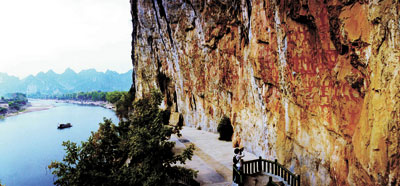
CHINA has applied for World Heritage status for the ancient rock painting on Huashan Mountain in the Guangxi Zhuang Autonomous Region in 2016.
According to China’s State Administration of Cultural Heritage, UNESCO has already made a preliminary review of the application. A series of official documents to protect the ancient site of rock paintings in Huashan Mountain were issued. So far, around 150 million yuan has been invested in relevant work to preserve the site. Better management and enhanced conservation efforts have been launched.
The rock paintings on Huashan Mountain are located on the west bank of the Mingjiang River in Yaoda Town, Ningming County, the Guangxi Zhuang Autonomous Region. They are the biggest, most content-rich and best-preserved ancient rock paintings in China among all the discovered cultural relics to date. With a history of around 1,800-2,500 years, the sites were made during religious rites by the ancient Luoyue people of the Zhuang ethnic groups in the drainage area of the Zuojiang River during the Warring States period (475-221 B.C.) and Eastern Han Dynasty (25-220).
The whole painting stretches more than 200 meters in length and around 40 meters in height made of more than 1,800 images, including people, horses, dogs, knives, swords and drums. Though a variety of archaeological theories have been put forth to explain the origin of the ancient artistic work, the exact reason for its creation remains a mystery.
(SD-Agencies)
|

